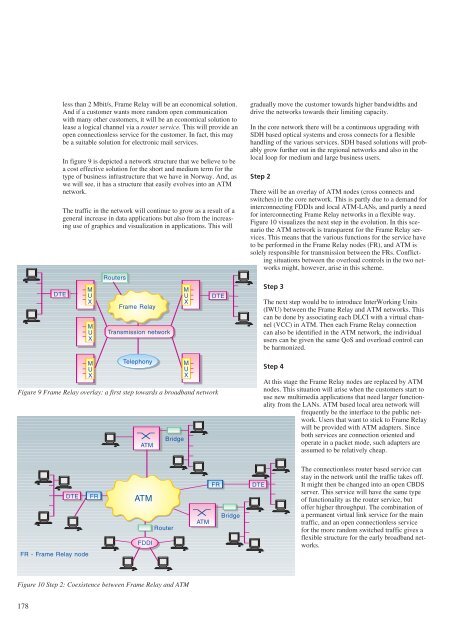Prognosemetoder – en oversikt - Telenor
Prognosemetoder – en oversikt - Telenor
Prognosemetoder – en oversikt - Telenor
Create successful ePaper yourself
Turn your PDF publications into a flip-book with our unique Google optimized e-Paper software.
178<br />
DTE<br />
less than 2 Mbit/s, Frame Relay will be an economical solution.<br />
And if a customer wants more random op<strong>en</strong> communication<br />
with many other customers, it will be an economical solution to<br />
lease a logical channel via a router service. This will provide an<br />
op<strong>en</strong> connectionless service for the customer. In fact, this may<br />
be a suitable solution for electronic mail services.<br />
In figure 9 is depicted a network structure that we believe to be<br />
a cost effective solution for the short and medium term for the<br />
type of business infrastructure that we have in Norway. And, as<br />
we will see, it has a structure that easily evolves into an ATM<br />
network.<br />
The traffic in the network will continue to grow as a result of a<br />
g<strong>en</strong>eral increase in data applications but also from the increasing<br />
use of graphics and visualization in applications. This will<br />
DTE<br />
FR - Frame Relay node<br />
M U<br />
X<br />
M U<br />
X<br />
M UX<br />
FR<br />
Routers<br />
Frame Relay<br />
Transmission network<br />
Telephony<br />
Figure 9 Frame Relay overlay: a first step towards a broadband network<br />
ATM<br />
ATM<br />
FDDI<br />
Router<br />
Bridge<br />
Figure 10 Step 2: Coexist<strong>en</strong>ce betwe<strong>en</strong> Frame Relay and ATM<br />
M U<br />
X<br />
M<br />
U X<br />
ATM<br />
DTE<br />
gradually move the customer towards higher bandwidths and<br />
drive the networks towards their limiting capacity.<br />
In the core network there will be a continuous upgrading with<br />
SDH based optical systems and cross connects for a flexible<br />
handling of the various services. SDH based solutions will probably<br />
grow further out in the regional networks and also in the<br />
local loop for medium and large business users.<br />
Step 2<br />
FR DTE<br />
Bridge<br />
There will be an overlay of ATM nodes (cross connects and<br />
switches) in the core network. This is partly due to a demand for<br />
interconnecting FDDIs and local ATM-LANs, and partly a need<br />
for interconnecting Frame Relay networks in a flexible way.<br />
Figure 10 visualizes the next step in the evolution. In this sc<strong>en</strong>ario<br />
the ATM network is transpar<strong>en</strong>t for the Frame Relay services.<br />
This means that the various functions for the service have<br />
to be performed in the Frame Relay nodes (FR), and ATM is<br />
solely responsible for transmission betwe<strong>en</strong> the FRs. Conflicting<br />
situations betwe<strong>en</strong> the overload controls in the two networks<br />
might, however, arise in this scheme.<br />
Step 3<br />
The next step would be to introduce InterWorking Units<br />
(IWU) betwe<strong>en</strong> the Frame Relay and ATM networks. This<br />
can be done by associating each DLCI with a virtual channel<br />
(VCC) in ATM. Th<strong>en</strong> each Frame Relay connection<br />
can also be id<strong>en</strong>tified in the ATM network, the individual<br />
users can be giv<strong>en</strong> the same QoS and overload control can<br />
be harmonized.<br />
Step 4<br />
At this stage the Frame Relay nodes are replaced by ATM<br />
nodes. This situation will arise wh<strong>en</strong> the customers start to<br />
use new multimedia applications that need larger functionality<br />
from the LANs. ATM based local area network will<br />
frequ<strong>en</strong>tly be the interface to the public network.<br />
Users that want to stick to Frame Relay<br />
will be provided with ATM adapters. Since<br />
both services are connection ori<strong>en</strong>ted and<br />
operate in a packet mode, such adapters are<br />
assumed to be relatively cheap.<br />
The connectionless router based service can<br />
stay in the network until the traffic takes off.<br />
It might th<strong>en</strong> be changed into an op<strong>en</strong> CBDS<br />
server. This service will have the same type<br />
of functionality as the router service, but<br />
offer higher throughput. The combination of<br />
a perman<strong>en</strong>t virtual link service for the main<br />
traffic, and an op<strong>en</strong> connectionless service<br />
for the more random switched traffic gives a<br />
flexible structure for the early broadband networks.
















